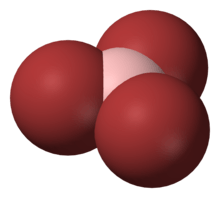Boron tribromide
 | |
| Names | |
|---|---|
| IUPAC name
Boron tribromide | |
| Other names
Tribromoborane, Boron bromide | |
| Identifiers | |
3D model (JSmol) |
|
| ChemSpider | |
| ECHA InfoCard | 100.030.585 |
| EC Number | 233-657-9 |
PubChem CID |
|
| RTECS number | ED7400000 |
| UNII | |
| UN number | 2692 |
| |
| |
| Properties | |
| BBr3 | |
| Molar mass | 250.52 g·mol−1 |
| Appearance | Colorless to amber liquid |
| Odor | Sharp and irritating[1] |
| Density | 2.643 g/cm3 |
| Melting point | −46.3 °C (−51.3 °F; 226.8 K) |
| Boiling point | 91.3 °C (196.3 °F; 364.4 K) |
| Reacts violently with water | |
| Solubility | Soluble in ethanol, CCl4 |
| Vapor pressure | 7.2 kPa (20 °C) |
Refractive index (nD) |
1.00207 |
| Viscosity | 7.31 x 10−4 Pa s (20 °C) |
| Thermochemistry | |
Heat capacity (C) |
0.2706 J/K |
Std molar entropy (S |
228 J/mol K |
Std enthalpy of formation (ΔfH |
-0.8207 kJ/g |
| Hazards | |
| Main hazards | Reacts violently with water, potassium, sodium, and alcohols; attacks metals, wood, and rubber[1] |
| Safety data sheet | ICSC 0230 |
| GHS pictograms |   |
| GHS signal word | DANGER |
| H330, H300, H314 Within the European Union, the following additional hazard statement (EUH014) must also be displayed on labeling: Reacts violently with water. | |
| NFPA 704 | |
| Flash point | Noncombustible[1] |
| US health exposure limits (NIOSH): | |
PEL (Permissible) |
None[1] |
REL (Recommended) |
C 1 ppm (10 mg/m3)[1] |
IDLH (Immediate danger) |
N.D.[1] |
| Related compounds | |
Related compounds |
Boron trifluoride Boron trichloride Boron triiodide |
Except where otherwise noted, data are given for materials in their standard state (at 25 °C [77 °F], 100 kPa). | |
| Infobox references | |
Boron tribromide, BBr3, is a colorless, fuming liquid compound containing boron and bromine. It is decomposed by water and alcohols.[2]
Chemical properties
Boron tribromide is commercially available and is a strong Lewis acid.
It is an excellent demethylating or dealkylating agent for the cleavage of ethers, also with subsequent cyclization, often in the production of pharmaceuticals.[3]
The mechanism of dealkylation of tertiary alkyl ethers proceeds via the formation of a complex between the boron center and the ether oxygen followed by the elimination of an alkyl bromide to yield a dibromo(organo)borane.
- ROR + BBr3 → RO+(−BBr3)R → ROBBr2 + RBr
Aryl methyl ethers (as well as activated primary alkyl ethers), on the other hand are dealkylated through a bimolecular mechanism involving two BBr3-ether adducts.[4]
- RO+(−BBr3)CH3 + RO+(−BBr3)CH3→ RO(−BBr3) + CH3Br + RO+(BBr2)CH3
The dibromo(organo)borane can then undergo hydrolysis to give a hydroxyl group, boric acid, and hydrogen bromide as products.[5]
- ROBBr2 + 3H2O → ROH + B(OH)3 + 2HBr
It also finds applications in olefin polymerization and in Friedel-Crafts chemistry as a Lewis acid catalyst.
The electronics industry uses boron tribromide as a boron source in pre-deposition processes for doping in the manufacture of semiconductors.[6] Boron tribromide also mediates the dealkylation of aryl alkyl ethers, for example demethylation of 3,4-dimethoxystyrene into 3,4-dihydroxystyrene.
Synthesis
The reaction of boron carbide with bromine at temperatures above 300 °C leads to the formation of boron tribromide. The product can be purified by vacuum distillation.
History
The first synthesis was done by M. Poggiale in 1846 by reacting boron trioxide with carbon and bromine at high temperatures:[7]
- B2O3 + 3 C + 3 Br2 → 2 BBr3 + 3 CO
An improvement of this method was developed by F. Wöhler and Deville in 1857. By starting from amorphous boron the reaction temperatures are lower and no carbon monoxide is produced:[8]
- 2 B + 3 Br2 → 2 BBr3
Applications
Boron tribromide is used in organic synthesis,[9] pharmaceutical manufacturing, image processing, semiconductor doping, semiconductor plasma etching, and photovoltaic manufacturing.
See also
References
- 1 2 3 4 5 6 "NIOSH Pocket Guide to Chemical Hazards #0061". National Institute for Occupational Safety and Health (NIOSH).
- ↑ "Boron Tribromide". Toxicologic Review of Selected Chemicals. National Institute for Occupational Safety and Health.
- ↑ Doyagüez, E. G. (2005). "Boron Tribromide" (pdf). Synlett. 2005 (10): 1636–1637. doi:10.1055/s-2005-868513.
- ↑ Sousa, C. & Silva, P.J (2013). "BBr3-Assisted Cleavage of Most Ethers Does Not Follow the Commonly Assumed Mechanism" (pdf). Eur. J. Org. CHem. 2013 (23): 5195–5199. doi:10.1002/ejoc.201300337.
- ↑ McOmie, J. F. W.; Watts, M. L.; West, D. E. (1968). "Demethylation of Aryl Methyl Ethers by Boron Tribromide". Tetrahedron. 24 (5): 2289–2292. doi:10.1016/0040-4020(68)88130-X.
- ↑ Komatsu, Y.; Mihailetchi, V. D.; Geerligs, L. J.; van Dijk, B.; Rem, J. B.; Harris, M. (2009). "Homogeneous p+ emitter diffused using borontribromide for record 16.4% screen-printed large area n-type mc-Si solar cell". Solar Energy Materials and Solar Cells. 93 (6–7): 750–752. doi:10.1016/j.solmat.2008.09.019.
- ↑ Poggiale, M. (1846). "Nouveau composé de brome et de bore, ou acide bromoborique et bromoborate d'ammoniaque". Comptes Rendus Hebdomadaires des Séances de l'Académie des Sciences. 22: 124–130.
- ↑ Wöhler, F.; Deville, H. E. S.-C. (1858). "Du Bore". Annales de Chimie et de Physique. 52: 63–92.
- ↑ Akira Suzuki, Shoji Hara, Xianhai Huang. "Boron Tribromide". e-EROS Encyclopedia of Reagents for Organic Synthesis. doi:10.1002/047084289X.rb244.pub2. Missing or empty
|url=(help)
Further reading
- Doyagüez, E. G. (2005). "Boron Tribromide" (pdf). Synlett. 2005 (10): 1636–1637. doi:10.1055/s-2005-868513.
External links
- Boron Tribromide at The Periodic Table of Videos (University of Nottingham)
- NIOSH Pocket Guide to Chemical Hazards - Boron Tribromide (Centers for Disease Control and Prevention)
- "Material Safety Data Sheet – Boron tribromide". Fisher Science.
- US patent 2989375, May, F. H.; Bradford, J. L., "Production of Boron Tribromide", issued 1961-06-20, assigned to American Potash & Chemical
